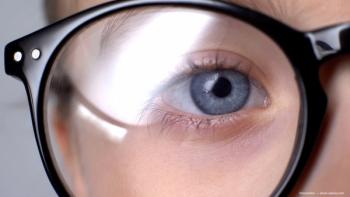
- Ophthalmology Times: August 2023
- Volume 48
- Issue 8
Cyropreserved amniotic membrane option for management of DED, NK
Treatment requires a systematic, multifaceted approach to improve outcomes.
Prolonged stress and unresolved inflammation can cause a vicious cycle that worsens the condition, leading to chronic DED.3 DED may also disrupt neural signaling from the ocular surface to the central nervous system, leading to progressive loss of corneal nerve density and eventual formation of neurotrophic keratitis (NK).2
NK is a degenerative corneal disease caused by impaired corneal sensory innervation.4 At the ocular surface, the trigeminal nerve contributes to sensation, controls blinking and tearing, and secretes trophic factors that support epithelial homeostasis and regeneration after damage.5 In NK, corneal nerve degeneration disrupts these processes and can lead to desiccating conditions that promote DED.2 There are significant overlaps in the pathology of the 2 conditions, including persistent epithelial defects and, in severe cases, corneal ulcers.
Diagnosing DED and NK
As DED and NK are interconnected in their pathogenesis, some patients may present with both conditions at the same time. In these cases, a careful evaluation of the patient’s signs and symptoms can help with diagnosis. For instance, in a typical eye with DED that has severe corneal staining, the patient experiences a significant amount of dry eye symptoms, such as burning, pain, foreign body sensation, and discomfort. In contrast, an eye with DED and NK may show intense corneal staining but lack proportionally severe symptoms because of the reduced corneal sensitivity.
DED is typically a bilateral condition. When a patient presents with asymmetric corneal staining, there is a reasonable chance that the eye with worse staining has NK. In addition to DED, practitioners should look for other risk factors of NK, such as diabetes, chronic topical medication usage, previous neurosurgical procedure, chemical burn, and a history of herpes or zoster infection.6
Once an eye is suspected to have NK, a corneal sensation test should be performed to confirm the diagnosis. Here, a Cochet-Bonnet aesthesiometer can be used to measure corneal sensitivity or a simple touch test can be done at the corneal surface using dental floss, gauze, or modified cotton swab. In a normal eye, the touch test will induce flinching or backing away from the slit lamp; lack of these responses or of patient-reported sensation indicates reduced corneal sensitivity and the presence of NK. Once diagnosed, DED and NK should be managed immediately to halt disease progression because late stages are much harder to manage.
Management of DED and NK
DED and NK are complex diseases that require a layered approach to management. The first step after diagnosis should be identifying and eliminating any factors that are exacerbating the conditions. For instance, patients should switch to preservative-free topical medications.
Practitioners should also focus on restoring the tear film and corneal epithelium recovery with treatments such as preservative-free artificial tears, punctal plugs, warm compresses, and nightly ointment.2 Anti-inflammatory treatments, such as cyclosporine (Restasis or Cequa, Sun Ophthalmics) and lifitegrast (Xiidra, Novartis), can help reduce inflammation in DED. Corticosteroids can control inflammation but may lead to undesired outcomes, such as IOP spikes and cataract formation.2,7 In eyes with both DED and NK, practitioners should address the underlying cause of neurotrophic cornea to reduce its contribution to dry eye.8
There are now several treatment choices available for NK. Cenegermin (Oxervate, Dompé) is a topical solution that contains recombinant human nerve growth factors, and it showed efficacy in promoting epithelial healing in moderate to severe NK.9 Another option is autologous serum tears, which are derived from the patient’s blood and contain growth and healing factors that promote regeneration.10
There are both logistical and financial challenges with these options. Cenegermin needs to be procured from a specialty pharmacy and sometimes requires a lengthy approval process with insurance companies. Serum tears are typically not covered by insurance and require a blood draw and formulation by a compounding pharmacy.
Cryopreserved amniotic membrane (CAM; Prokera, BioTissue) is a good adjunct to these options because it is readily available in the office and can be placed on the cornea right after diagnosis of the disease.
CAM is a corneal bandage produced from placenta and contains growth factors and HCHA/PTX3, a key protein complex with anti-inflammatory and antiscarring properties.11,12
CAM has a rapid mechanism of action and produces positive results, typically within a week. CAM also addresses both DED and NK by simultaneously suppressing inflammation and promoting corneal reinnervation. Compared with dried amniotic membranes, CAM is more effective at promoting epithelial cell growth,13 and its companion ring provides added structural stability when placed on
the cornea.
Firsthand experience with CAM
I use CAM extensively across a number of conditions, particularly in NK and nonhealing epithelial defects. Compared with other options, CAM has the advantage of effectively repairing the ocular surface in a short amount of time. After a 5-day treatment, there are already appreciable improvements in corneal staining and appearance. By starting CAM early, we can control and reverse the diseases before they develop into late stages that are more difficult to manage.
Some patients complain about discomfort after CAM placement, so I find it helpful to instruct the patient to close their eye for about a minute immediately after insertion to help them adjust to the new sensation. I also remove the ring after 5 to 7 days, because prolonged treatment is not beneficial once the membrane is dissolved. Precare consultation should involve discussions of both the benefits and the anticipated foreign body sensations. After setting expectations, most patients can tolerate minor discomforts linked with CAM.
Both DED and NK are chronic diseases that are difficult to manage alone and challenging when presented concurrently. Treatment will require a systematic and multifaceted approach to improve outcomes and patient satisfaction. In this context, CAM is a valuable tool that rapidly repairs the ocular surface and prepares the cornea for long-term disease management.
Beeran B. Meghpara, MD
P: 215-928-3180
Meghpara is a fellowship-trained ophthalmologist at WillsEye Hospital in Philadelphia, Pennsylvania, specializing in cornea, cataract, and laser refractive surgery. He has extensive experience with advanced technology IOL implants that correct astigmatism and presbyopia.
References:
Aragona P, Giannaccare G, Mencucci R, Rubino P, Cantera E, Rolando M. Modern approach to the treatment of dry eye, a complex multifactorial disease: a P.I.C.A.S.S.O. board review. Br J Ophthalmol. 2021;105(4):446-453. doi:10.1136/bjophthalmol-2019-315747
Mead OG, Tighe S, Tseng SCG. Amniotic membrane transplantation for managing dry eye and neurotrophic keratitis. Taiwan J Ophthalmol. 2020;10(1):13-21. doi:10.4103/tjo.tjo_5_20Tong L, Lim L, Tan D, et al; Corneal Subspecialty Workgroup, College of Ophthalmology, Academy of Medicine, Singapore. Assessment and management of dry eye disease and meibomian gland dysfunction: providing a Singapore framework. Asia Pac J Ophthalmol (Phila). 2021;10(6):530-541. doi:10.1097/APO.0000000000000417
NaPier E, Camacho M, McDevitt TF, Sweeney AR. Neurotrophic keratopathy: current challenges and future prospects. Ann Med. 2022;54(1):666-673. doi:10.1080/07853890.2022.2045035
Sacchetti M, Lambiase A. Diagnosis and management of neurotrophic keratitis. Clin Ophthalmol. 2014;8:571-579. doi:10.2147/OPTH.S45921
Bonini S, Rama P, Olzi D, Lambiase A. Neurotrophic keratitis. Eye (Lond). 2003;17(8):989-995. doi:10.1038/sj.eye.6700616
Phulke S, Kaushik S, Kaur S, Pandav SS. Steroid-induced glaucoma: an avoidable irreversible blindness. J Curr Glaucoma Pract. 2017;11(2):67-72. doi:10.5005/jp-journals-l0028-1226
Lambiase A, Sacchetti M, Mastropasqua A, Bonini S. Corneal changes in neurosurgically induced neurotrophic keratitis. JAMA Ophthalmol. 2013;131(12):1547-1553. doi:10.1001/jamaophthalmol.2013.5064
Bonini S, Lambiase A, Rama P, et al; REPARO Study Group. Phase II randomized, double-masked, vehicle-controlled trial of recombinant human nerve growth factor for neurotrophic keratitis. Ophthalmology. 2018;125(9):1332-1343. doi:10.1016/j.ophtha.2018.02.022
Kojima T, Higuchi A, Goto E, Matsumoto Y, Dogru M, Tsubota K. Autologous serum eye drops for the treatment of dry eye diseases. Cornea. 2008;27(suppl 1):S25-S30. doi:10.1097/ICO.0b013e31817f3a0e
Tseng SCG. HC-HA/PTX3 purified from amniotic membrane as novel regenerative matrix: insight into relationship between inflammation and regeneration. Invest Ophthalmol Vis Sci. 2016;57(5):ORSFh1-ORSFh8. doi:10.1167/iovs.15-17637
Koizumi NJ, Inatomi TJ, Sotozono CJ, Fullwood NJ, Quantock AJ, Kinoshita S. Growth factor mRNA and protein in preserved human amniotic membrane. Curr Eye Res. 2000;20(3):173-177.
Thomasen H, Pauklin M, Steuhl KP, Meller D. Comparison of cryopreserved and air-dried human amniotic membrane for ophthalmologic applications. Graefes Arch Clin Exp Ophthalmol. 2009;247(12):1691-1700. doi:10.1007/s00417-009-1162-y
Articles in this issue
about 2 years ago
Standardizing terminology for clarity in refractive surgeryabout 2 years ago
Dry eye renaissance: Escalating cases meet with innovationabout 2 years ago
There’s more to cataract surgery than meets the eyeabout 2 years ago
Unlocking geographic atrophyNewsletter
Don’t miss out—get Ophthalmology Times updates on the latest clinical advancements and expert interviews, straight to your inbox.



















































.png)


